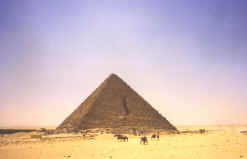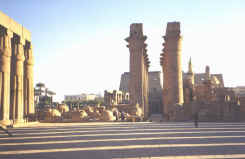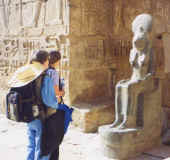|
"Time
& Space in the Temples & Pyramids" |
Day-by-Day Itinerary for "Time & Space in the Temples & Pyramids"
|
CLICK all pictures to ENLARGE. Use BACK arrow to return to page. Day
0, Sat., September 9, 2006: For
those beginning their tour in New York, USA, our plane leaves NY City
6:30 PM on Saturday, September 9, 2006. Your American Tour Leader,
Ruth Shilling, meets the group at JFK airport in New York City and
accompanies the group on the flight to Egypt. We fly direct
non-stop from New York city, USA to Cairo, Egypt. Other departure
cities in the USA are available as add-on's. Contact
Us for pricing. Day
1, Sunday, September 10:
Midday
arrival in Cairo (7 hours ahead of New York time, 2 hours ahead of
Greenwich). Cairo is the biggest center of culture and learning in
the Middle East, and one of the largest, most crowded cities in the
entire world. We begin with a panoramic view of the whole city
from the Citadel. Here we also visit one of the most
beautiful mosques in the city, the famous Mohammed Ali Mosque, also
called the "Alabaster Mosque".   We spend time inside the Red Pyramid (nearly as large as Giza's
Great Pyramid) and then have the opportunity for an unforgettable walk
across the open desert to the Bent Pyramid. The desert is
rich with inspiration and the vastness is exhilarating. The Bent
pyramid was a key center of worship during the Middle Kingdom, and was
much more important than Giza at that time. It is the only pyramid
to retain most of its original casing stones.
We spend time inside the Red Pyramid (nearly as large as Giza's
Great Pyramid) and then have the opportunity for an unforgettable walk
across the open desert to the Bent Pyramid. The desert is
rich with inspiration and the vastness is exhilarating. The Bent
pyramid was a key center of worship during the Middle Kingdom, and was
much more important than Giza at that time. It is the only pyramid
to retain most of its original casing stones.
Afterwards, we enjoy an Ancient Egyptian style meal prepared just for our group at a nearby guesthouse. We are served the same foods that we will later see depicted in the wall reliefs at Sakkara, inscribed 4,500 years ago!
Optional: Evening visits to a local Carpet School where they make wool, silk and simple camel hair carpets and/or a Papyrus Institute if you would like.
Optional: Evening visits to a Perfume Oil Shop and/or the Sound & Light Show at the Giza pyramids this evening. Day 4, Wed, Sept 13: FREE DAY WITH OPTIONS*. You may be ready for a day relaxing by the pool as you gaze up at the pyramids. Time to write those postcards at last or organize your things before leaving for Upper Egypt tomorrow? Or you may choose from the following options: 1) Day trip into Cairo to see the Coptic churches in the area known as "Old Cairo." Afterwards explore the colorful Kahn al-Khalili bazaar. Enjoy shopping and bargaining, linger over dinner at the famous historic Naguib Mafouz restaurant or try smoking some shisha (flavored tobacco) at an outdoor cafe. 2) Take a day-long to trip to Alexandria. With the feel of a European city, Alexandria is quite different than the rest of Egypt. Your trip includes visits to the Catacombs of Kom el Shugafa, "Pompey's Pillar," the Roman Amphitheater and the Greco-Roman Museum. Or you may prefer to spend the whole day at the newly opened Alexandria Library. Return to Cairo by evening. 3) Shopping in Cairo. Visit the Avenue of the Tent-makers in the old city where you can buy appliquéd items directly from the makers, Kerdasa - where they make a wide variety of galebeya dresses and the Kahn El Khalili bazaar for wide variety of goods, including belly dancing costumes. Shopping escorted and assisted by Ruth. *Note: On this free day, your lunch and dinner are not included. All other meals on the tour are included in your tour price (and you get to order whatever you would like, we pick up the tab!). Evening
Options:
Evening (10:15 PM) one-hour flight to Luxor. Accommodation: Luxor Hilton or similar, 5 star hotel, located directly on the Nile.
The west represented the hereafter and is where the dead were buried. Today we visit perhaps the most colorful tombs presently available for viewing in Luxor, the Workman's Village, Deir El Medina, gives us a look at some of the tombs most often represented in books about Ancient Egypt. Whereas on Wednesday at Sakkara we saw scenes of daily life during the Old Kingdom, today we see the daily life represented during the New Kingdom (about 1,000 years later). Next
we see the rarely visited Ramesseum, a favorite of many of our
travelers. This is where the fallen statue of Ramesses II
inspired a poem by Shelley.
In the late-afternoon and early evening we visit to the Luxor Temple when the lighting is optimal for seeing the wall reliefs. The dramatic lighting also helps give the temple a special feeling in the evening. Both gently beautiful and full of awesome grandness, this temple was the "Bride of Karnak" during the annual Apet festival.
Optional
evening opportunities:
We will also stop at one of the local Alabaster Shops, if there is an interest. (Better to buy this sort of thing at the very end of your trip.)
Return flight to Cairo this evening, so that you will be ready to take the Tuesday morning flight back to New York, or another destination. Or board a Nile Cruise boat to continue your Egypt tour with a Nile Cruise & Abu Simbel extension provided by our affiliate, American Express of Egypt. Day
10, Tuesday, September 19:
Flights home or spend more time enjoying the riches of Egypt. See
options at Day 4
for suggestions. Prices and What Is Included in this September 10-19, 2006 Tour |
All Photos on
this page are by Ruth Shilling,
except the Sun Temple - taken by one of our travelers, Ken Reynolds.



















